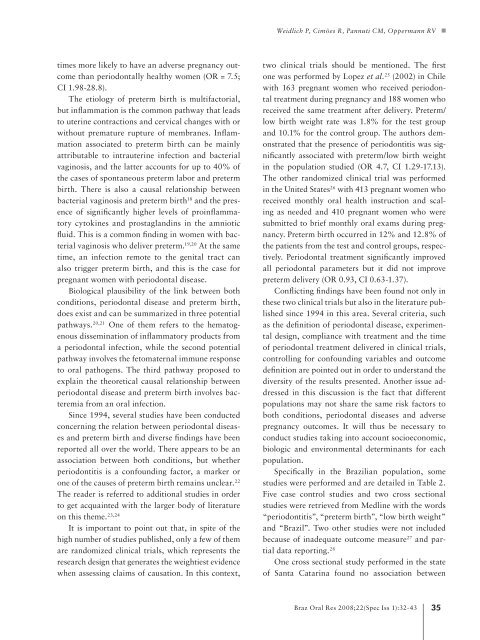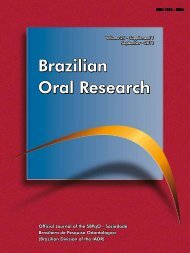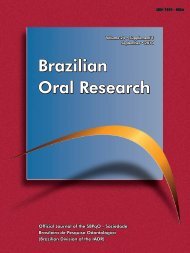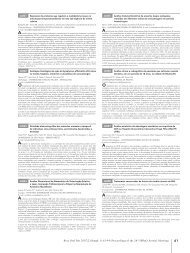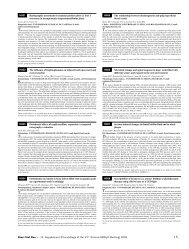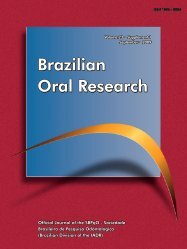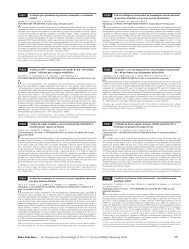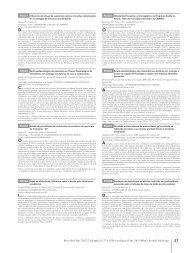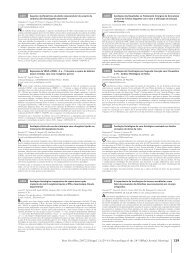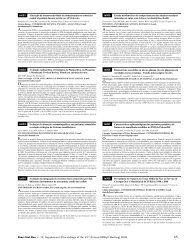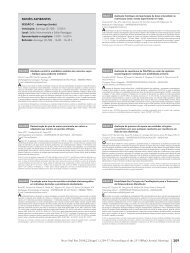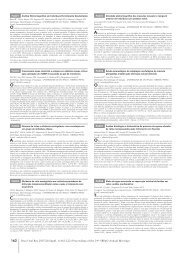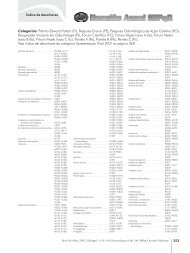Brazilian Oral Research Brazilian Oral Research Brazilian Oral
Brazilian Oral Research Brazilian Oral Research Brazilian Oral
Brazilian Oral Research Brazilian Oral Research Brazilian Oral
You also want an ePaper? Increase the reach of your titles
YUMPU automatically turns print PDFs into web optimized ePapers that Google loves.
times more likely to have an adverse pregnancy outcome<br />
than periodontally healthy women (OR = 7.5;<br />
CI 1.98-28.8).<br />
The etiology of preterm birth is multifactorial,<br />
but inflammation is the common pathway that leads<br />
to uterine contractions and cervical changes with or<br />
without premature rupture of membranes. Inflammation<br />
associated to preterm birth can be mainly<br />
attributable to intrauterine infection and bacterial<br />
vaginosis, and the latter accounts for up to 40% of<br />
the cases of spontaneous preterm labor and preterm<br />
birth. There is also a causal relationship between<br />
bacterial vaginosis and preterm birth 18 and the presence<br />
of significantly higher levels of proinflammatory<br />
cytokines and prostaglandins in the amniotic<br />
fluid. This is a common finding in women with bacterial<br />
vaginosis who deliver preterm. 19,20 At the same<br />
time, an infection remote to the genital tract can<br />
also trigger preterm birth, and this is the case for<br />
pregnant women with periodontal disease.<br />
Biological plausibility of the link between both<br />
conditions, periodontal disease and preterm birth,<br />
does exist and can be summarized in three potential<br />
pathways. 20,21 One of them refers to the hematogenous<br />
dissemination of inflammatory products from<br />
a periodontal infection, while the second potential<br />
pathway involves the fetomaternal immune response<br />
to oral pathogens. The third pathway proposed to<br />
explain the theoretical causal relationship between<br />
periodontal disease and preterm birth involves bacteremia<br />
from an oral infection.<br />
Since 1994, several studies have been conducted<br />
concerning the relation between periodontal diseases<br />
and preterm birth and diverse findings have been<br />
reported all over the world. There appears to be an<br />
association between both conditions, but whether<br />
periodontitis is a confounding factor, a marker or<br />
one of the causes of preterm birth remains unclear. 22<br />
The reader is referred to additional studies in order<br />
to get acquainted with the larger body of literature<br />
on this theme. 23,24<br />
It is important to point out that, in spite of the<br />
high number of studies published, only a few of them<br />
are randomized clinical trials, which represents the<br />
research design that generates the weightiest evidence<br />
when assessing claims of causation. In this context,<br />
Weidlich P, Cimões R, Pannuti CM, Oppermann RV<br />
two clinical trials should be mentioned. The first<br />
one was performed by Lopez et al. 25 (2002) in Chile<br />
with 163 pregnant women who received periodontal<br />
treatment during pregnancy and 188 women who<br />
received the same treatment after delivery. Preterm/<br />
low birth weight rate was 1.8% for the test group<br />
and 10.1% for the control group. The authors demonstrated<br />
that the presence of periodontitis was significantly<br />
associated with preterm/low birth weight<br />
in the population studied (OR 4.7, CI 1.29-17.13).<br />
The other randomized clinical trial was performed<br />
in the United States 26 with 413 pregnant women who<br />
received monthly oral health instruction and scaling<br />
as needed and 410 pregnant women who were<br />
submitted to brief monthly oral exams during pregnancy.<br />
Preterm birth occurred in 12% and 12.8% of<br />
the patients from the test and control groups, respectively.<br />
Periodontal treatment significantly improved<br />
all periodontal parameters but it did not improve<br />
preterm delivery (OR 0.93, CI 0.63-1.37).<br />
Conflicting findings have been found not only in<br />
these two clinical trials but also in the literature published<br />
since 1994 in this area. Several criteria, such<br />
as the definition of periodontal disease, experimental<br />
design, compliance with treatment and the time<br />
of periodontal treatment delivered in clinical trials,<br />
controlling for confounding variables and outcome<br />
definition are pointed out in order to understand the<br />
diversity of the results presented. Another issue addressed<br />
in this discussion is the fact that different<br />
populations may not share the same risk factors to<br />
both conditions, periodontal diseases and adverse<br />
pregnancy outcomes. It will thus be necessary to<br />
conduct studies taking into account socioeconomic,<br />
biologic and environmental determinants for each<br />
population.<br />
Specifically in the <strong>Brazilian</strong> population, some<br />
studies were performed and are detailed in Table 2.<br />
Five case control studies and two cross sectional<br />
studies were retrieved from Medline with the words<br />
“periodontitis”, “preterm birth”, “low birth weight”<br />
and “Brazil”. Two other studies were not included<br />
because of inadequate outcome measure 27 and partial<br />
data reporting. 28<br />
One cross sectional study performed in the state<br />
of Santa Catarina found no association between<br />
Braz <strong>Oral</strong> Res 2008;22(Spec Iss 1):32-43


